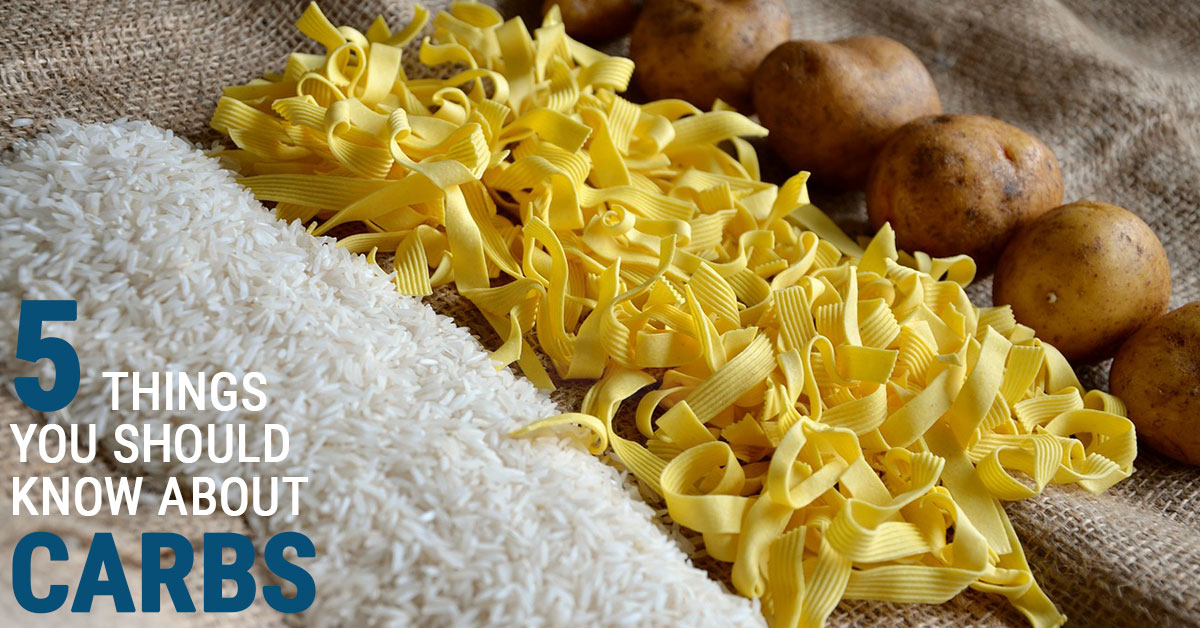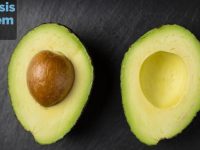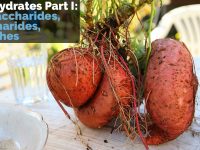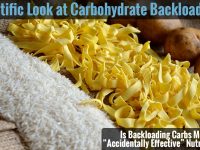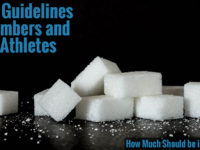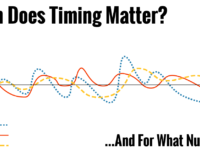Carbohydrates are deceptively complex. While their place in the diet is relatively easy to understand because their main function is provide energy, many people don’t realize some finer points about carbohydrates and as a result wind up with skewed or illogical beliefs.
Since carbohydrates will play a central role in many of the articles on this blog, it seems a good idea to address some of these points head-on and hopefully stanch the misunderstanding before it can pool. So then, here are five basic lessons on how carbohydrates work (or do not work):
#1: All Carbohydrates Are Made Out of Sugar
You know how sometimes the media portrays sugar as this evil, toxic substance that has no redeeming values? It makes no sense. I mean, it makes sense to eat a healthy, nutrient-dense diet—and foods that are high in sugar are rarely healthy or nutrient-dense—but sugar is made of the exact same building blocks as any other carbohydrate.
Provided your diet is otherwise fine, basic biochemistry doesn’t really care if your carbs come from oats or honey. That’s because all carbohydrates are built out of the sugars glucose, fructose, and galactose. The shells of crabs are made of sugars, as are the trunks of trees and the fiber in your oatmeal. If it’s a carbohydrate, it’s built out of sugar.
Okay, so I realize that when the media attacks sugar, they’re think of mono- and disaccharides like high-fructose corn syrup and sucrose, not the building blocks of complex carbs, but there’s still a fundamental misunderstanding that makes it hard to put the actual harms of excess sugar in the proper context. If your only goal is to harvest the energy from a carbohydrate, then it really doesn’t matter if that carbohydrate is “complex” or “simple” because they’re both made of the same, basic thing that you need.
I’m not advocating for a high-sugar diet, I just think it’s important to understand that sugar is the basic building block of all carbohydrates, and it is not dangerous in and of itself. It’s the context that makes sugar dangerous, the same as the context can make other carbohydrates, fat, and even protein dangerous. In the context of an active climber who eats a basically healthy diet and doesn’t eat too much, sugar calories are fine.
#2: Fructose Can Be Used as Energy
If sugar is vilified in general, fructose is super-vilified. Fructose is blamed for all manner of woes faced by today’s society, from obesity to non-alcoholic fatty liver disease to inflammation. Usually, the rationale for why fructose is so bad is that the body cannot use it as energy or effectively metabolize it.
First, let’s acknowledge that this is correct from a kindergartian understanding of biochemistry—fructose is not a preferred energy source, and anytime there is glucose available (which is always) it will always take precedence over the fructose. But fructose does still get used as energy most of the time because it gets converted by the liver into glycogen which is then released to the blood as glucose.
If we’re going to use this as evidence that fructose cannot be used as energy, then we might as well also say that fat can’t be used as energy because it must be converted to acetyl-CoA first. Obviously, that’s ridiculous.
When we eat fructose, the liver pulls it all up in order to create liver glycogen. Whereas the muscles resist using fructose as an energy source anytime glucose is around, the liver is the exact opposite—whenever there is both glucose and fructose available, the liver will preferentially use the fructose to make glycogen. The liver can store 80-100 grams of glycogen, which is more than enough to soak up the typical person’s fructose intake without necessitating any fructose-to-fat conversion.
In the end, fructose is little more than a scapegoat. Yes, it can contribute to obesity, non-alcoholic fatty liver disease, and general inflammation, but the reality is that these afflictions are due to variety of factors, not just fructose. In you, my presumably active climbing reader, it’s incredibly unlikely that fructose will ever do more than top off the glycogen tank of your liver.
#3: There Is a Limit on Carbohydrate Absorption
For most of the history of nutritional science, it was assumed there was no limit on carbohydrate absorption. We know better now.
A little over 10 years ago, sports scientists discovered that the intestinal transporter responsible for moving glucose from the intestine to the blood would get saturated when glucose intake was roughly 1 gram per minute—in other words, only a single gram of glucose could press through each minute while the rest waited in line. Practically speaking, this means you can only absorb about 60 grams of glucose per hour.
This doesn’t exactly overturn everything we thought we knew about carbohydrates, but it does suggest that there is little difference between eating a single large carb-rich meal vs. numerous smaller ones, at least so long as they provide equal amounts of glucose over equal periods of time. It also suggests that the common piece of sports nutrition advice to “eat small amounts of carbohydrates frequently after a workout to restore muscle glycogen” has no advantage.
There’s a catch, though: fructose uses a different transporter than glucose, which can mop up an additional 30 grams of fructose and bring the total absorption of carbohydrates to roughly 90 grams per hour. So even though fructose is really not bad in most contexts, it can increase the amount of carb calories you absorb per hour by 50%, which is fairly significant if you eat a lot of sweets.
Of course, most people won’t absorb a full 60 grams (or 90 grams with fructose) per hour because a mixed-meal will slow digestion down; it’s only when you consume a very simple glucose- or fructose-containing food like candy or soda that those carbohydrates can be sucked up at maximum speed. But if you are going to binge on something rich in simple carbohydrates, you’re hypothetically better off with just glucose.
#4: Carbohydrates Are the Reason for Your GI Distress, Not “Food Sensitivies”
It’s a fact of life: food can sometimes make you feel bad. Sometimes we can definitively determine the culprit, such as in a food allergy, and other times it’s a one-off event, like with food poisoning—but there’s also a third scenario where some foods seem to make you feel poorly (especially in the bowels) but there’s no clear reason why.
A common catch-all reason is a “food sensitivity”, which is usually defined as a low-grade immune reaction—not quite an allergy, but with long-lasting and subtle effects. The problem is that food sensitivities have zero scientific evidence going for them, which is a good indicator that they probably don’t exist since immune reactions increase specific biomarkers that should be easy to spot and replicate in the lab. In the meantime, though, researchers not pursuing wild geese have found a much more likely culprit: fermentable carbohydrates, more commonly called “FODMAPs”.
FODMAP is an acronym that stands for “fermentable oligo-, di-, monosaccharides and polyols”, and what they all have in common is that they can be digested by the gut bacteria. For the majority of people, this is not a problem—and in fact fermentable carbohydrates are a good thing for most because they encourage a healthy gut flora—but some people have difficulty digesting them and suffer a slew of GI symptoms from bloating to diarrhea to cramping and everything in-between when they consume them.
The FODMAP hypothesis is still relatively new and needs more thorough testing, but in the early stages it’s already vastly more promising than any research on so-called food sensitivities. In fact, when people with self-diagnosed food sensitivies (like “gluten intolerance”) were put in a double-blind placebo-controlled trial, all gastrointestinal symptoms could be tied to FODMAPs and none could be tied to food sensitivities.
So yes, more research needs to be done, as a meta-analysis warned this year—but it also concluded that the research we have so far is promising and that a low FODMAP diet significantly reduced overall symptoms—including abdominal pain and bloating—in people with gastrointestinal disorders. If this applies to you, then FODMAPs are at the very least a great place to start, and you can learn more about a low-FODMAP diet here.
Oh, and just to tie this all back to fructose again, remember how you can only absorb about 30 grams of fructose per hour? Well, the rest of it is happily fermented by your gut bacteria, leading to many of the symptoms listed above. Yes, fructose is the monosaccharide (the “M”) in FODMAPs, and it can cause symptoms in susceptible individuals even in lower amounts. But again, most people ferment carbohydrates just fine, so don’t run off and restrict your diet for no reason.
#5: You Can Train Carbohydrate Metabolism
I’ve talked briefly in the past about fat-adaptation and how it’s not really in a climber’s best interest. Training carbohydrate metabolism is a similar concept, but (probably) equally doomed to failure as far as performance goes.
When fat-adaptation first began picking up steam, the premise was that you would “train low and race high”—that is, do your training in a low-carbohydrate state but compete with ample carbohydrate availability. Hypothetically, training low would boost your fat metabolism and then when you competed you’d have even more energy available because you have all that fat energy plus the carbohydrate energy. It didn’t work out that way.
We discovered relatively quickly on that every gain made in fat metabolism was fully compensated for by a reduction in carbohydrate metabolism. After learning to burn fat as the main fuel, the athletes’ muscle no longer wanted to burn carbohydrates, and their total available aerobic energy remained the same (anaerobic energy decreased).
It can also go the other way, though. By eating a high-carbohydrate diet, your muscles better learn to use carbohydrates as fuel with probable similar decreases in fat metabolism (I say probable because it’s not well-researched, but I would be surprised if you just magically “gained” energy).
What this really means is that the best diet to train with is the diet you plan on performing with—it doesn’t ever seem to work out to manipulate your training diet because you create metabolic changes that are not as quickly reversed as your diet. If you plan on taking advantage of the significant ergogenic benefits of carbohydrates, then you might as well train with them, too.
The Five Lessons
Let’s recap quickly:
- All carbohydrates are made out of simple sugars, and provided your diet is otherwise healthy and you don’t eat too much then those simple sugars are no more likely to harm you coming from a donut than from a bowl of barley.
- Fructose is not some evil, unmetabolizable carbohydrate, but rather the perfect fuel for replenishing your liver glycogen. The only time fructose will get converted to fat is when your caloric intake is so high that there’s no liver glycogen to refill—of course, in the case of a caloric excess your body is just as happy to store glucose or fat as fat, too.
- You can only absorb 60 grams of glucose and 30 grams of fructose per hour, and in the context of a complex meal you won’t even absorb that much. Thus, it probably makes little difference whether you eat a lot of carbs at once or spread them out over a few hours so long as the total intake and time remains the same.
- Carbohydrates are much more likely to be causing any GI distress you might have than proteins, the supposed cause of “food sensitivities”. If you have GI distress, try removing FODMAPs from your diet. Be sure to start adding them back in one at a time after you eliminate them so you don’t pointlessly restrict your diet.
- You can train carbohydrate metabolism during exercise, but it’ll probably come at the cost of fat metabolism. You can train fat metabolism during exercise, but it’ll definitely reduce your carbohydrate metabolism. Your best bet is to keep your diet moderately consistent as far as fat and carbohydrate content goes.
Keep these in mind as we plow ahead—I guarantee they’ll come up again!
